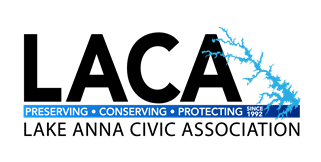By Harry Looney – February 2025
Anyone that uses Lake Anna for recreational purposes knows that the upper parts of the lake have been under recreational advisories issued by the Virginia Department of Health (VDH) each year since 2018 due to cyanobacteria Harmful Algal Blooms (cHABs). It is clear from research conducted at Lake Anna over the past six years and more than thirty years of peer reviewed research on cyanobacteria issues around the country and the world, that the primary contributor to cyanobacteria growth is excess nutrients (phosphorus and nitrogen).
The Virginia General Assembly distributed funding in the fiscal year 2024 state budget to start a cHAB mitigation program at Lake Anna. The Lake Anna Advisory Committee (LAAC) worked with the Lousia County staff to release a competitive request for proposals to identify companies and technical approaches to reduce excess levels of phosphorus in the three main tributaries of Lake Anna (North Anna River, Pamunkey Creek, and Terry’s Run). The LAAC developed a five-year phosphorus remediation methodology that included a Concept Development phase in year-1 of the effort. The long-term goal of the 5-year LAAC project is to improve water quality in Lake Anna and to reduce excess phosphorus that is the primary source of the cHABs we have been experiencing.
The LAAC received viable technical proposals from two contractors, EutroPHIX, a division of SePRO Corporation, and Clean Streams Rivers and Lakes (CSRL), and both contractors were selected to be part of the Concept Development effort in 2024. The Concept Development phase included phosphorus remediation treatments in the North Anna River and Terry’s Run. Pamunkey Creek was the control area where no treatments were applied.
The EutroPHIX project scope included the application of phosphorus inactivating products both directly to the North Anna tributary of Lake Anna, as well as to the North Anna River upstream of the lake to reduce phosphorus inputs from the watershed.
The CSRL project scope included the application of phosphorus inactivating products to the Terry’s Run tributary of Lake Anna and the use of innovative, beneficial bacteria “bioreactors” to grow and sustain bacteria that compete with the cyanobacteria for nutrients and other sources of energy.  The products from both companies have a wide margin of safety for aquatic organisms, fish, birds, mammals, and humans, and the treatments were reviewed and approved by the Department of Wildlife Resources (DWR) and Dominion Energy.
The products from both companies have a wide margin of safety for aquatic organisms, fish, birds, mammals, and humans, and the treatments were reviewed and approved by the Department of Wildlife Resources (DWR) and Dominion Energy.
The contracts included an outcome-based measure of performance (MOP). The Phase 1 MOP was a 10% reduction in excess phosphorus as measured at the final sampling of the calendar year. The LAAC monitored the upper lake throughout the year to determine the amount of improvement in water quality and effectiveness of the treatments. In addition, the upper lake continued to be monitored by the Virginia Department of Environmental Quality (DEQ) and the Lake Anna Civic Association (LACA) and both contractors were required to conduct water quality monitoring as part of their technical approach.
Data from phosphorus samples collected at multiple stations in each tributary show that both contractors exceeded the 10% reduction of excess phosphorus outcome-based MOP. Phosphorus data from sampling conducted at three stations on Pamunkey Creek (the control area for the Concept Development phase) also showed reductions of excess phosphorus levels.
The reductions that were achieved provide evidence that the technical approaches used by the two contractors will result in the reduction of excess phosphorus in Lake Anna, but more work is required to fully understand the data. We will continue to review the data to determine the effect that environmental conditions such as the drought the area experienced in the summer of 2024 might have had on the phosphorus reductions we measured. In addition, the LAAC is developing plans for what can be conducted in 2025 with the funding we have available. That plan will be presented to the Committee at the LAAC meeting in March 2025.
harry.looney@lakeannavirginia.org
